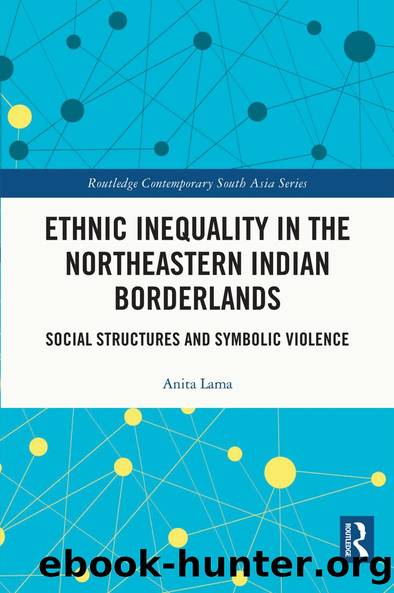Ethnic Inequality in the Northeastern Indian Borderlands by Anita Lama

Author:Anita Lama [Lama, Anita]
Language: eng
Format: epub
Tags: History, Asia, India & South Asia, Social Science, Ethnic Studies, General, Regional Studies
ISBN: 9781000331028
Google: XsYKEAAAQBAJ
Publisher: Routledge
Published: 2020-12-23T05:05:58+00:00
Revenue Order No.1 of 1917 and other related documents
Revenue Order No.1 of 1917 aimed to protect the land of indigenous Bhutias and Lepchas from immigrant Nepalis. This notification can be well understood in the wake of the Chogyal retaining full administrative power and in the context of British policy lessee landlordism that changed the socio-economic and religio-political order of Sikkim. In order to establish British supremacy in the administrative affairs of Sikkim, the first political officer J.C White resorted to weakening the pro-Chogyal aristocrats by stripping them off their landholdings and curtailing their influence and power. At the same time, to further their capitalist pursuits, they disrupted the social order of Sikkim with large-scale settlement of immigrants from Nepal, also as lessee landlords. In this respect, Revenue Order No.1 can be considered as an outcome, to protect the lands of the indigenous groups as it was issued in 1917 when full power was being transferred to the Chogyal.
However, these policies failed to take into consideration the interests of the Sikkimese Limbus. This is chiefly because the policy aimed to protect the lands of the indigenous from the Nepali immigrants and the Limbus were already classified as Nepalis in 1915. Therefore, while Revenue Order No.1 protected the lands of the Bhutia-Lepcha as indigenous, it subjected the lands of the Limbus to ownership from immigrant as well as indigenous groups. Second, considering the transfer of administrative power to the Chogyal, this notification aimed to reinstate the legitimacy of the Bhutia-Lepcha group as indigenous to colonial Sikkim and therefore protected their socio-economic interests. On the contrary, this declaration, while upholding only the Bhutia-Lepcha group as indigenous, symbolically devalued the Limbus as immigrant Nepalis thereby legitimizing their subordination, as implied in this policy, which was clearly discriminatory in the context of Sikkimese Limbus.
Revenue Order No.1 was issued on 17th May 1917 as a notification to all Kazis, Thikadars and Mandals66 in Sikkim, that no Bhutias and Lepchas were to be allowed to sell their lands to any person other than a Bhutia or Lepcha without the express sanction of the Darbar, or Officer empowered by the Darbar on this behalf67. To this end, Revenue Order No.1 was formulated to restrict the land ownership of immigrant Nepalis in Sikkim by protecting only the lands of the Bhutia-Lepchas in colonial Sikkim, which arguably also links to Buddhist religion, as symbolized by the Chogyal. This is also consistent from several reports and notifications that were issued thereafter that aimed to check the transfer of Bhutia-Lepcha land to immigrant Nepalis. In particular, it put emphasis on protecting their northern territory from the immigrant Nepalis. For example, the Administrative Report of the State of Sikkim for the year 1931â32 states that Nepalese being ânon-hereditaryâ subjects were not allowed to settle beyond the Dikchu river in the north to prohibit land alienation of Bhutias and Lepchas described as âpoor and improvident, getting speedily replaced by the latterâ (referring to Nepali settlers or domiciled plainsmen) âwho are more subtle and shrewdâ68.
Download
This site does not store any files on its server. We only index and link to content provided by other sites. Please contact the content providers to delete copyright contents if any and email us, we'll remove relevant links or contents immediately.
| Central Asia | Southeast Asia |
| China | Hong Kong |
| India | Japan |
| Korea | Pakistan |
| Philippines | Russia |
The Sympathizer by Viet Thanh Nguyen(4308)
The Rape of Nanking by Iris Chang(4140)
World without end by Ken Follett(3432)
Ants Among Elephants by Sujatha Gidla(3417)
Blood and Sand by Alex Von Tunzelmann(3140)
Japanese Design by Patricia J. Graham(3112)
City of Djinns: a year in Delhi by William Dalrymple(2516)
The Queen of Nothing by Holly Black(2499)
Foreign Devils on the Silk Road: The Search for the Lost Treasures of Central Asia by Peter Hopkirk(2435)
India's Ancient Past by R.S. Sharma(2417)
Inglorious Empire by Shashi Tharoor(2396)
Tokyo by Rob Goss(2390)
In Order to Live: A North Korean Girl's Journey to Freedom by Yeonmi Park(2348)
India's biggest cover-up by Dhar Anuj(2319)
Tokyo Geek's Guide: Manga, Anime, Gaming, Cosplay, Toys, Idols & More - The Ultimate Guide to Japan's Otaku Culture by Simone Gianni(2316)
The Great Game: On Secret Service in High Asia by Peter Hopkirk(2306)
Goodbye Madame Butterfly(2209)
Batik by Rudolf Smend(2128)
Living Silence in Burma by Christina Fink(2038)
